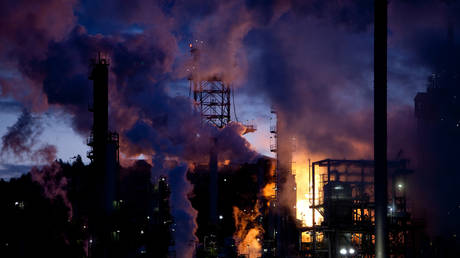Trump tariff announcement drives oil prices to four-year low
Oil prices have fallen below $60 per barrel, marking the lowest level in over four years, as markets prepare for the repercussions of the ongoing trade war and diminishing global demand. Brent crude, which serves as the global benchmark, slipped...

Brent crude, which serves as the global benchmark, slipped to approximately $61 per barrel, while US West Texas Intermediate dropped to around $58, both reaching their lowest points since February 2021.
The decline began after US President Donald Trump announced extensive tariffs on most imports last week. Since that announcement, prices have plummeted by about 16% amid escalating concerns that a global trade war could hinder economic growth and reduce fuel consumption. The situation intensified on Wednesday with the implementation of Trump’s tariffs, which, despite excluding energy imports, triggered a significant market reaction.
The latest tariffs have raised the rate on Chinese goods to 104%, an increase from the previously announced 34%. In response, China has matched with a 34% tariff of its own, prompting the White House to escalate its stance further.
The Chinese Commerce Ministry pledged to respond decisively, heightening fears of a wider economic slowdown. Analysts express concern that ongoing tensions between these two major economies could negatively impact trade and investment.
Meanwhile, OPEC and its allies, including Russia, exacerbated market pressures by announcing a 411,000 barrel-per-day production increase for May. Analysts suggest that this move could result in oversupply and further price declines.
“Crude oil has been in free-fall ever since President Trump unveiled fresh tariffs on US imports Wednesday evening,” Trade Nation senior market analyst David Morrison remarked in a note provided to Business Insider. He described the OPEC+ production boost as a “double whammy.”
Morrison anticipates that oil prices may stabilize within a limited range, as investors brace for weaker demand alongside strong supply. He pointed out that this trend aligns with Trump’s objectives of providing low energy prices to bolster manufacturing.
According to J.P. Morgan, the White House has been aiming to reduce crude prices to $50 or even lower. Trump reinforced this objective on Monday, stating on Truth Social: “Oil prices are down, interest rates are down,” while emphasizing the advantages of his trade strategy.
Russia was not affected by the new tariffs, as the White House indicated that existing sanctions already “preclude any meaningful trade," rendering further measures unnecessary.
However, Russia’s central bank has cautioned that the downturn in oil prices coupled with the escalating trade conflict could jeopardize its economy. “If the escalation of the tariff wars continues, this usually leads to a decline in global trade and the global economy, and possibly, demand for our energy resources,” central bank head Elvira Nabiullina stated on Tuesday.
Additionally, Russia's Urals crude experienced a sharp decline, briefly approaching the $50-per-barrel mark for the first time in almost two years, before recovering to approximately $67.
Ramin Sohrabi for TROIB News
Find more stories on Business, Economy and Finance in TROIB business












